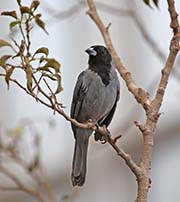Black-faced Tanager - Schistochlamys melanopis
| Length | |
| Weight | |
| Clutch Size | |
| Chicks at birth | |
| IUCN Conservation Status | |
Continents: |
The Black-faced Tanager is a South American bird and can be found in Bolivia, Brazil, Colombia, Ecuador, French Guiana, Guyana, Paraguay, Peru, Suriname, and Venezuela. There are five subspecies of this bird.
Black-faced Tanagers upperparts are dark gray with the underparts a lighter gray. The head and bib are black. The bill is also black with a bluish-gray base. The eyes are a dark red. Both sexes look identical. Juveniles are a dark yellowish olive green with lighter underparts. They also have a pale yellow eye-ring.
Diet: Black-faced Tanagers eat fruit, berries, seeds and some insects. They forage in the upper portions and crowns of small trees and shrubs.
Courtship: Found no information on their courtship. They are usually found in pairs or small family groups.
Nesting: They build an open cup nest of grass in low vegetation at the edge of an open space. Usually two grayish or yellowish-white eggs with dark spots are laid. Both parents raise the young.
Habitat and Range: Tropical and sub-tropical lowland forests and foothills, dry savannas and scrubland. They prefer grasslands with low trees and bushes.
Vocalization: Their song is rhythmic and usually consists of 3 or 4 rich, flutelike whistled phrases that is sung in about 3 seconds with a pause of 10 seconds between calls.
Plumage/Molt Black-faced Tanagers do not have an alternate plumage and probably molt annually.
Migration: Non-migratory but some Black-faced Tanagers from Brazil may seasonally migrate.
Tongue/feet: Feet and legs are dark gray.
Bibliography:
- Isler, Morton L. and Isler, Phyllis R., The Tanagers: Natural History, distribution, and Identification,Smithsonian Institution Press, Washington D.C., 1987
- http://en.wikipedia.org The Free Encyclopedia, Accessed December, 2012
- http://www.aviary.org/animals/ National Aviary, Pittsburg, Penn., Accessed December, 2012



